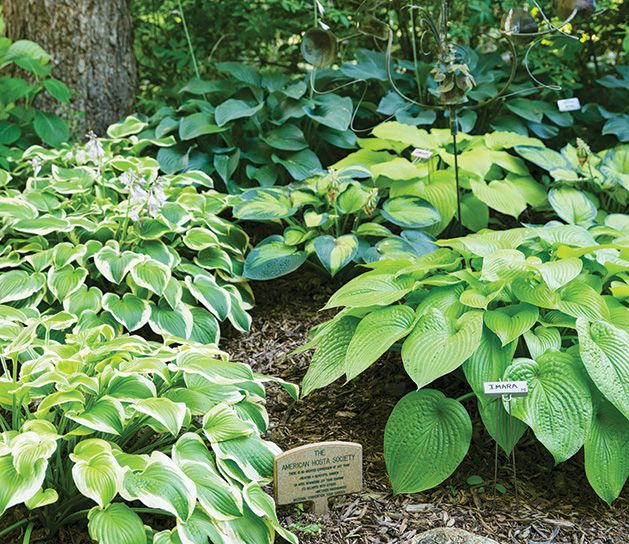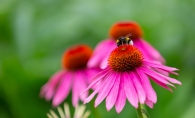
Larry and Kathy Welliver only need to walk a few steps from the front door of their Maple Grove home to immerse themselves in a garden oasis. Hostas—big and small in size; green to yellow in color; and curly to quilted in texture—play a starring role in this bucolic setting, blanketing much of the grounds around the house.
It’s no wonder Welliver calls himself “Larry the Hosta Guy” on social media. The Wellivers’ garden is very much a joint venture for the retired couple, who have three grown children and four grandchildren, but Kathy quips that Larry is in charge.

In all, the garden contains 750 different varieties of hostas. They have many of the same variety, raising the actual number of hostas residing there into the thousands. The hostas are used as a border for the landscape in many spots in the yard.
For Larry, the reason for his devotion to hostas is simple: He likes the look of the multi-colored foliage. “I’m a color person,” says Larry, who has had a green thumb ever since he was a boy growing up in Richfield (as did Kathy). “I just love the color of the (hosta) leaves and the variation within some of the leaves,” he says. “You can have a green leaf with a white edge or a yellow edge,” he says. “You can have a green leaf with a white center. You can have kind of blueish colors, yellows and a lot of different variations.”

AVID GARDENERS
The Wellivers have loyally tended and tilled to their garden ever since they moved to their house in 1980. What was once surrounded by horse stables, farmland and dirt roads is now surrounded by suburbia.
Larry started dabbling with hostas in 1985. That’s when Kathy’s mother gave them some basic varieties. He happily discovered planting them meant cutting less grass on his five-acre lot. It wasn’t until a few years later, on a garden tour, when he first became captivated by the plant’s budding potential for his own yard. “We saw hostas that we have never seen before,” says Larry, who retired in 2000 from his job as vice president of the Honeywell Solid State Electronics Center in Plymouth. “I was like, ‘Oh, man, we have to get into that.’”

And, they did. In fact, their garden was featured on the 2000 American Hosta Society convention tour, which was in Minneapolis that year. “A few people told us it was the best privately maintained garden they have ever seen,” Larry says.
Maintaining the garden—especially weeding—takes a lot of work. Helping them are three high school- and college-age young men. Occasionally, hostas will die, and they will have to be replaced. But that doesn’t happen much. “They’re hardy,” Kathy says. “Once you get them going, there’s not a lot to do.”
Hostas do well in Minnesota since they need frozen ground in the winter months to thrive in the summer. “Our hostas here tend to be a lot bigger than in southern areas, where the ground doesn’t freeze as long,” Larry says. These sizes range with the different varieties, and some can be up to three or four feet across.

PEACEFUL SETTING
When the garden is at its lushest, motorists often slow down in front of their house to take a look. Larry and Kathy don’t mind. They enjoy sharing the garden with others.
After all these years, they still love looking at it, too. One of their favorite spots is on their patio, where they sit, surrounded by tall trees, several pieces of their vast collection of lawn art and hostas, of course. “Especially, in the later spring, when everything is up, and the colors are so vivid,” Kathy says. “It’s amazing how many shades of green there are.”
The land is slated for change, but the couple is preserving the hostas and the rest of the garden on the acre surrounding the house. Despite changes, the garden retains its natural charm. Squirrels, chipmunks, owls, foxes, coyotes and deer all make appearances from time to time. Larry says they see more wildlife in their yard than they do on their frequent trips Up North. “Not counting the bears,” Kathy says. “We don’t see bears here, but that’s it,” Larry says. “That’s the only thing we don’t see.”
HUNTING THE HIDDEN
For a hosta enthusiast, such as Robert Olson, MD, it was a once-in-a-lifetime expedition.
The year was 1995, and the St. Louis Park resident helped organize a trip to search for hostas growing in the wilderness of Japan. Dr. Olson says most hostas come from mutations or hybridization of a few species from Japan (and to a lesser extent China and Korea).
Plant hunters helped him and others in the group find the hostas. Dr. Olson, a retired gastroenterologist, who began gardening with hostas in the early 1980s, is the past president of the American Hosta Society, a member of the Minnesota Hosta Society and the longtime editor of The Hosta Journal.
“They aren’t easy to find,” he says of hostas in Japan. “Not many gardens have them in Japan, but these plant hunters took us to remote islands, where we had to forage raging streams, raging in our eyes anyway.”
Dr. Olson climbed a mountain to see hypoleuca, known for the powdery white coating on the back of its leaves. “They grow on the sides of mountains, and you can see in your mind’s eye how a bird somehow dropped a seed there,” he says.
Dr. Olson brought one home, and it continues to grow, on the edge of a stone wall in his garden. “So it can lean over outside like it’s supposed to,” he says.
SHEDDING LIGHT
For those who want to plant hostas, Larry Welliver has some advice: Do your research.
According to the University of Minnesota Extension, hostas thrive in sites where filtered or dappled shade is available for much of the day, and they can survive in deep shade (less than four hours of sun a day), too.
“They need to know about shade; some do better in the sun than others,” Welliver says. “Hostas are pretty tolerant of most types of soil. You don’t want to put them in a wet spot, and you need to understand the size because some of these can get quite large. You want to be careful how you put big ones and little ones in.”
For more on hostas, visit the American Hosta Society at americanhostasociety.org and the Minnesota Hosta Society at mnhosta.org.
Instagram: @larrythehostaguy
Facebook: Larry The Hosta Guy
Twitter: @larrywelliver









